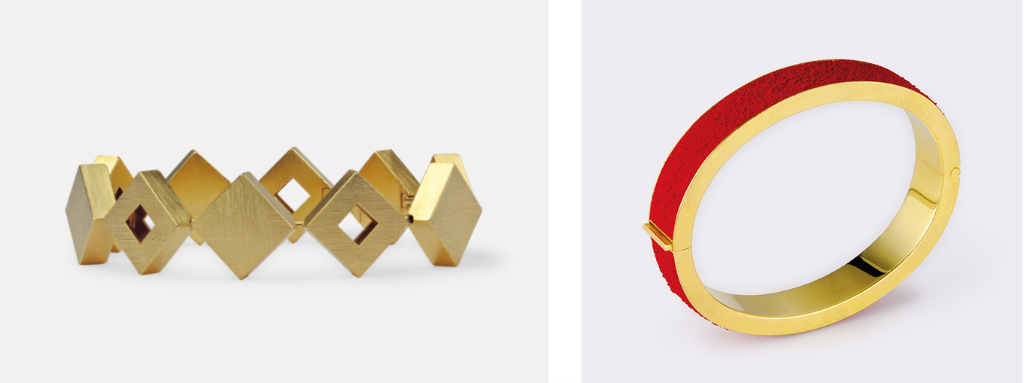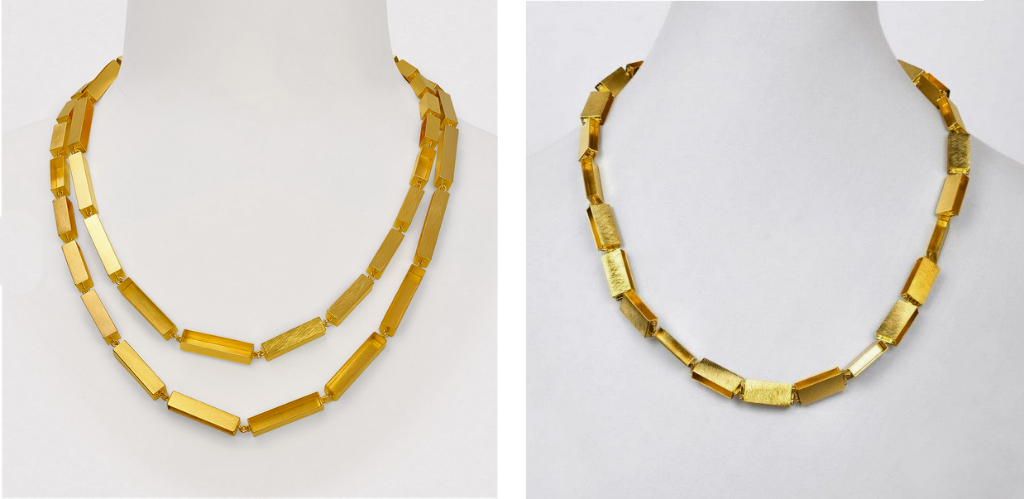
Michael Becker or the Beauty of Geometry
Cornelie Ueding and Jürgen Wertheimer
Gold plates, titanium discs, dolomite rocks, severe, ascetic shapes, distinct lines: seldom is a first glance more deceptive than a casual observer seeing Michael Becker’s jewelry. Concealed behind the geometric severity and aesthetic perfection are poetry and passion, indeed a desire for beauty bordering on obsession.

You could also say that the visible severity is a consequence of a passionate urge to capture a cosmic disorder, while at the same time trying to tame this chaos, halting every movement while setting everything imaginable in motion. Static and dynamic are hardly opposites in the work of Michael Becker, no more than artificiality and nature.

He is a master of transitions, metamorphoses and transformations ‒ and it is no exaggeration to say that almost his entire work straddles the line between organization and unleashing energies.

Macro and micro perspectives
Approaching earth. Fissured mountain ridges, meandering river deltas or human settlements come into view as if from an altitude of 10,000 meters. Three-dimensional models of the earth or traces of cometary movements, metamorphoses of cosmic images and miniatures from outer space ‒ all of them topographies and by no means mere figments of the imagination.

Ever since his first brooches, with their spaces based on Palladio ground plans framed by gold foil, Michael Becker has been partial to the view from above: starting from way up high, approaching from a remote distance and putting giant land masses in miniature frames. Naturally, done in such a way that crude verism never comes to mind. These are no kitsch reproductions, nature scaled down or cutesified. On the contrary, the reliefs and folds, peaks and valleys re-emerge in the mind of the beholder. The jewelry piece, the blue or gray or green stones, lapis lazuli, gray dolomite or green granite, are perhaps catalysts, awakening images in our minds or eliciting a secret normally blocked from view.
What goes for stones and landscapes also applies to the threshold between rest and motion.

Petrified landscapes, images in motion
Liquid dolomite, rock-hard streams ‒ if it were possible to work with red-hot lava, Michael Becker would probably not hesitate to experiment with it, so strong is his desire to set every static geometry in motion. Always in his mind’s eye is the image of a tumbling cube, whose never-ending movements ‒ tilting, falling and rolling ‒ he meticulously traces, in slow motion, with the help of a paper model whenever he links the pieces of a necklace in calculated rhythms or asymmetric patterns.

In slow motion: because many of his square or rectangular, gently curving or lightly twisted links in the chain appear to move, and not just on the arm or neck of its wearer. They move by virtue of little, precisely calculated rhythmic shifts in order, as if something were in motion, never coming to a standstill but continuously flowing. Static, representative jewelry ‒ bedecked and adorned is the last thing Becker wants. Of course, nothing wild either, no uncontrollably exuberant drifting: the movements are calm and composed, never straying beyond the laws of gravity and geometry. A small chapter of this mini aesthetic should be devoted to Becker and his love of the beauty of geometry. He literally gives the appearance of being an alchemist of applied art, bent over his drawings and paper models, measuring, surveying in a painstaking (not pedantic) manner. But always in search of an ideal state, a moment he maybe wished would stand still.

Measuring beauty
For Becker, measuring beauty presupposes classical training. Vitruv, Leonardo, L. B. Alberti – time and again it’s the great classical aesthetes of the Renaissance he cites as his sources. Far from being slavish, he deals with them so sure-footedly that the mystery of the double square (to name just one of the many ordering and proportioning systems he works with) and his derivations with a compass, the ordered shifts in proportion, seem like his artistic theory of everything.

The squaring of jewelry creation, in his case, has something perfectionistic and analytic in terms of approach, something playfully light in its results. It’s all about miniatures in this aesthetic tinker’s laboratory ‒ as if the fate of the world depended on it. And perhaps the fate of the world really does depend on it, a world in which proportions are harmoniously coordinated, when position and inclination of a tiny bent titanium plate are being decided in his workshop on Artilleriestrasse in Munich.

The geometry of beauty knows no compromises, only laws of regularity. With their bends and turns, some of his jewelry pieces resemble chromatic scales as soon as they are worn, continually modeling and paraphrasing the tones. Who would have thought that necklaces not only glitter with the slightest movement, but even produce sounds? Music of the spheres ‒ thank heavens it’s all just a very earnest game. The genre of applied art can vouch for this, with its constant striving to keep the human element in mind. There is no such thing, after all, as necklaces, bracelets or rings beyond their wearers, owners and users ‒ the human beings they are made for. And so it is this double movement, the movement of movement, that really brings Becker’s artefacts to life.

Play of light, world of colors
Indeed, the actual medium of bringing jewelry and artefacts to life is light. Reflections, shading, shadows and movements are aspects that can enliven even the hardest of materials. Becker’s colors do the same: lapis lazuli from Afghanistan, gray dolomite from China, green granite from Siberia, brilliant red, which is only to be had in the form of pigment, and not to be forgotten: gold, whose dull-polished surface he employs in the entire gamut of dark-and-light variations, predominantly as a source of color. For Becker, choosing colors always means imposing severe restrictions on himself. Because it’s important to him that colors are permanent too, and not just painted on or liable to fade. Which doesn’t mean that incident light, the skillfully constructed cross-fading of double layers or the precisely structured frames around spaces and colored stones do not allow strips of light to fall on the landscape of stones, constantly transforming them, now shining bright, now gleaming mysteriously, and sometimes smoldering darkly.

In common parlance, the term Gesamtkunstwerk ‒ a total work of art, a synthesis of the arts ‒ is almost always associated with the idea of greatness, even gigantomania. We could, to wind up, give it another meaning here and, at the risk of sounding somewhat paradoxical, speak of Gesamtkunstwerke en miniature with respect to Becker’s work. Little Gesamtkunstwerke that, by highly artificial means, go straight to the heart of life and are in themselves message enough. No metaphors, no symbols, let alone myths. The thing-in-itself, its very idea, its materialization, its coming to life on the body of its wearer are mystery enough.

Not least of all, Becker’s works of jewelry are a medium of visual and tactile communication, sending out light signals with every movement and every shift of light. In a world rife with a flood of virtual images, an imaginative re-ordering of the concrete capacities for sensual experience is almost a political issue. What all of this boils down to is nothing short of a reconquest of our own perception, of materiality, of “thingness.” Thus, Michael Becker’s jewelry pieces are instruments in the struggle for our own sense and sensibility, for a tangible mysticism of “superficiality.”
